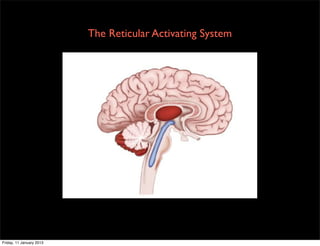Ras
•
2 recomendaciones•1,760 vistas
The Reticular Activating System (RAS) is a network of neurons that extends from the brainstem to different parts of the brain and spinal cord. It functions to regulate arousal, alertness, and selective attention by increasing or decreasing activity and directing cortical areas to focus on relevant information. Destroying the RAS causes a coma similar to sleep, while stimulating it instantly awakens sleeping animals. The Thalamus filters and relays incoming sensory information, with the exception of smell, to cortical areas. It plays a role in attention by emphasizing certain information and regulates arousal through its connection to the RAS.
Denunciar
Compartir
Denunciar
Compartir
Descargar para leer sin conexión

Más contenido relacionado
La actualidad más candente
La actualidad más candente (20)
Cerebrospinal fluid, Anatomy and Physiology, Nervous system

Cerebrospinal fluid, Anatomy and Physiology, Nervous system
Differences sympathetic system vs parasympathetic system

Differences sympathetic system vs parasympathetic system
Destacado (14)
Similar a Ras
Similar a Ras (20)
Topic 4 The brain and neuropsychology - how does your brain affect you?

Topic 4 The brain and neuropsychology - how does your brain affect you?
Más de Crystal Delosa
Más de Crystal Delosa (20)
U301 part b reforming the victorian criminal justice system

U301 part b reforming the victorian criminal justice system
U402 a court processes and procedures (working progress)

U402 a court processes and procedures (working progress)
Ras
- 1. The Reticular Activating System Friday, 11 January 2013
- 2. In topic 2 - Brain Structures and Processes we will learn about many areas of the brain and their functions. We will learn how they communicate (neurons and neurotansmitters) and control bodily functions. However to understand normal waking consciousness in particular attention, we need to jump ahead and look at the Reticular Activating System and the role of the Thalamus. Friday, 11 January 2013
- 3. The reticular activating system Is a network of neurons extending in many directions from the reticular formation in the brainstem to different parts of the brain and spinal cord Functions include: • Arousal, e.g. regulates by increasing or decreasing • Alertness, e.g. regulates wakefulness and attention • Selective attention, e.g. regulates what we choose to attend to, directs specific cortical areas to focus on relevant information Evidence for these functions includes: • Destroying the RAS causes a coma resembling sleep • Electrical stimulation of RAS instantly awakens sleeping animals Friday, 11 January 2013
- 4. Thalamus Is a small structure on the top of the brain stem that filters and relays incoming sensory information (except smell) to relevant cortical areas. Information moves from cortical areas to lower brain structures, the spinal cord and out to the peripheral nervous system. Function: • Plays a role in attention by actively filtering incoming sensory information, giving more weight to and emphasising certain information. • Regulates arousal through connection with the RAs. • Closes pathways of incoming information during sleep, preventing information from reaching the brain as it rests Friday, 11 January 2013
